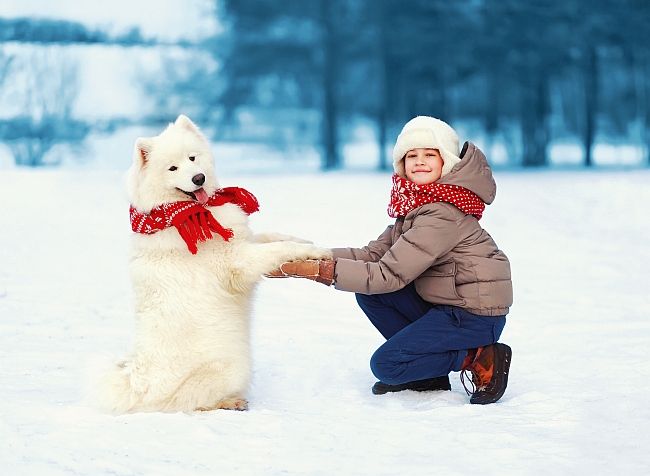The changing seasons bring in new challenges for domestic pets. Colder weather, harsher winds, rains, snow, and ice cause pet owners to take greater precautions when it comes to protecting their canine and feline companions. Find out some of the biggest threats pets faces when winter sets in.
Chemical products: Anti-freeze is something kept close at hand during chilly months. Many pet owners keep ice-melting products in their garages or closets for quick accessibility, but these products are highly poisonous for pets. The downside is, the liquid is disarmingly fresh to the taste when pets lick the outside of the bottle; but the toxicity is deadly. Be sure to keep all anti-freeze products far out of the way so you pet isn’t tempted. SYMPTOMS: If you suspect your cat or dog may have ingested some anti-freeze, they will show signs of walking around aimlessly, bumping into objects. They will drool excessively, show signs of extreme thirst, repeatedly urinate, vomit or potentially go into seizures. At any of these signals be sure to take your pet to the veterinarian immediately.
Hypothermia: Even though your pet has a thick fur coat that does not mean he is not vulnerable to colder climates. While the temperatures outside are changing, be attentive to your cat or dog, ensuring that he has a warm place to rest, without any cold drafts or breezes come through. Try to keep his coat dry and his bedding snug to avoid the dangers of hypothermia.
Ice melts: The sodium chloride and calcium chloride that can be found on city sidewalks dressed in holiday style, can be dangerous for puppy paws. Not only does the salt dry out the animal’s paws, but it can cause cracking, stinging and burning. After every walk, take some gentle wipes and glaze over your pet’s paws. Or, as a warmer alternative, use a shallow bowl filled with warm water as foot bath for the moment your dog comes in from the salt-strewn streets.
Frozen paws: Breeds with sleek short hair tend to be less susceptible to freezing paws than longer-haired breeds. Dogs like Huskies, Collies, and Golden Retrievers grow thick hair between their toes, which, when exposed to cold weather and damp or snowy grounds can result in ice clumps gathering in the fur between the toes. This affects a dog’s balance, ability to exercise and walk properly, and can be painful.
Paw protection tips: In the winter, an animal’s paws can get the worst of the wear and tear. Use moisturizing balms to sooth dryness and cracks in their foot pads. At night, throw some pooch-socks on their feet so that the ointment can have a maximal effect. If you live where there are extremely brutal winters, invest in some “snow shoes” for your canine friend. Throwing some booties on those toes will help your dog get the amount of exercise he needs, even on days when the roads are covered in salt, snow and ice. When you are relaxing by the fire at home, keep an eye on your pup to ensure that he is not over-licking his paws. If this means resorting to an Elizabethan collar for a time, then so be it. Helping your pet’s feet stay healthy in the winter is an important part of his well-being.

